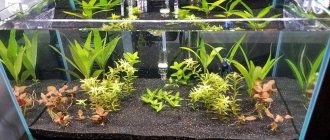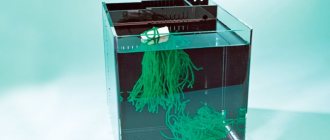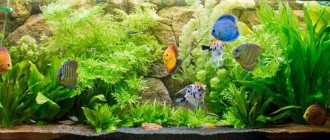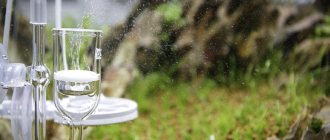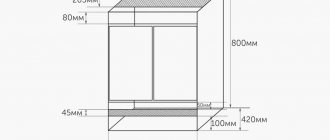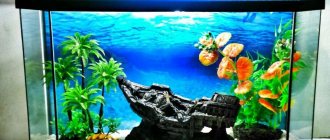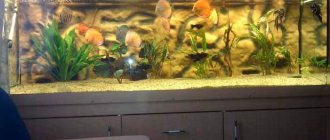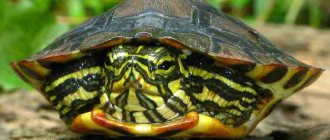Growing tropical plants in our houses and apartments is not so easy. Dry air just kills them, and if not, they don't look their best. Therefore, many people think about how to create suitable conditions for them. Unfortunately, not many people can boast of their own greenhouse or winter garden, but anyone can plant them under glass. We will talk further about how to make a florarium with your own hands. And don't be scared. You will need a little space, at least until the first experiment. Then the number of mini-gardens in the bank begins to grow catastrophically. But the problem with gifts has been solved, because the price of a ready-made garden in a bottle is quite immodest.
What is a florarium
Back in the mid-19th century, someone once came up with the idea of planting plants in a glass container. The experiment turned out to be very successful. The composition looked great, the plants developed and even bloomed. By analogy with aquariums and terrariums, such glass gardens began to be called “florariums”.
There is just a sea of ideas. This is just for starters...
Today, terrariums for flowers are made mainly in special glass or plastic vases, flasks and other containers. Succulents and moss are most often planted. There are people who like to grow tropical plants. They love high humidity, so a closed container is for them. Orchids and other plants that can grow without soil feel great in florariums. Since the containers are sealed, it is possible to create conditions for semi-aquatic and marsh plants, but this version of an aquarium garden is called a paludarium.
Sizes may not be small
If desired, you can buy a mini-garden in a vase. But making a florarium with your own hands is not so difficult, and it will bring much more joy. It may not be easy to find the right combination of soil components and matching plants, but there are some proven combinations. You can see them in the photo, but choosing them yourself is much more interesting.
Where can you place such a decorative element?
It is necessary to install a new piece of furniture depending on its purpose.
In order for a handmade item to become a decoration for your home, it is important to place it in an advantageous place for viewing:
- A candlestick and night light will look good in the bedroom on the bedside table.
- It is recommended to position the florarium so that the plants do not experience a lack of sunlight.
- A glass chest and display case for heirlooms will look great in a living room where the whole family gathers.
- It is recommended to place small containers filled with small items on bookshelves, racks, and coffee tables.
Using installations from unnecessary aquariums, you can decorate niches, openings, corners, protrusions and minor defects in wall decoration.
Containers for florariums
The sizes of florariums vary widely - from several hundred milliliters to tens and even hundreds of liters. The shapes are also very diverse, but balls and cylinders predominate. To make a florarium with your own hands, it is not necessary to buy a container. If you have an abandoned aquarium of any shape, a large jar or vase, you can use them. True, they must meet certain requirements:
- The container for florariums should help retain moisture. Balls or other containers with holes in the side are perfect for this. It’s a little worse if the hole is on top, but it is of a smaller diameter. Vessels that are even across the entire width are suitable for cacti and succulents. They don't need high humidity. But if you want, you can also plant a tropical plant. But in this case you will need a lid.
A mini-garden can be in the most ordinary jars. It is important that the glass is white and transparent - The height of the container must be sufficient to lay all the necessary layers of soil. Plus, you will need to plant the plants so that their height is taken into account. At least a third of the container should be free, and preferably half.
- The glass must be transparent, not colored. The walls must let in enough light.
An excellent container for a florarium: the humidity level is maintained, the walls are transparent, easy to care for.
For testing, you can make a florarium in a jar of an unusual shape or an inexpensive container. When you master all the intricacies, including the features of care, you will be able to build something more serious.
Turning on the equipment
As soon as you fill the aquarium with water (you can directly from the tap), turn on the filtration and heating of the water in the aquarium (set the heating temperature to 25°C). After a couple of days, check the water temperature with a thermometer to make sure that the temperature you set is maintained in the aquarium. Even with the most expensive heaters, the thermostat scale may not be accurate.
Leave the aquarium alone for a few more days with the equipment turned on. This is necessary for the initial colonization of the soil and biofilter with colonies of beneficial bacteria. A certain amount of the necessary bacteria is always present even in a new aquarium. In addition, you can introduce a starter culture of bacteria (you can buy them at a pet store) or take some water or soil from another existing aquarium, unless you are afraid of introducing pathogenic bacteria. Since there is no sludge in the new aquarium for the bacteria to feed on, they need to be fed. There is no need to use special products; for this purpose, just add a little fish food to the water, the result will not be worse.
From this point on, it is important that the thermostat and filters work constantly; this is a necessary condition for starting the aquarium
What plants to plant
The choice of plants for a florarium is limited by the volume in which you plan to pack them. For beginners, it is best to start with succulents and cacti. Species diversity, different shapes and colors allow you to create different compositions. These plants do not grow too quickly and require minimal care.
Moss and succulents make very cute and varied compositions.
As a short-term project, you can make a florarium with early flowering bulbous plants. These are snowdrops (all types), tulips, hyacinths, etc. The time can be chosen so that by the appointed date (New Year, birthday, March 8, etc.) the flowers release buds or begin to bloom.
The simplest version of a garden in a vase is bulbous plants
When creating compositions, it is advisable to select the composition of plants not only by appearance. It is easier to care for a mini-garden in a vase if the plants have the same growing conditions. In this case, they can be planted in the ground. But if you are using "non-dwarf" sized plants, it is easier to remove from the pot. The pots are camouflaged with sand or decorative stones.
A similar technique - in separate pots - allows you to grow plants in one florarium that need to be cared for differently. But then you need to remember what, when and in what quantity to water, feed, etc. This is not acceptable for everyone, as it requires attention.
Equipment
You can't do without a filter and a compressor. Only fastidious plants need a carbon dioxide supply system. A heater is also optional.
Lighting
Lighting can be arranged above the surface of the water using fluorescent or LED lamps
It is important to keep fish that are not prone to jumping out of the water. Choose lamps with white light to prevent algae from fouling your glass.
Remember that yellow and green light bulbs stimulate algae growth. Place the small tank away from sunlight.
Filter
For a small aquarium, an internal filter or an external one with a tube is suitable. Check that the filter material can be easily removed for washing. In an hour, the filter should distill a volume of water equal to 8–15 volumes of the aquarium, without creating a powerful pressure. In a small volume, you can entrust aeration to a filter, but it is better if there are two different devices. Plants act as an additional source of oxygen. A suitable filter should be small and unobtrusive.
Water heater
A heater in a small aquarium is necessary if the room temperature is too low for a particular type of pet. Monitor temperature fluctuations by installing a thermometer.
Succulents for the garden in a jar
Succulents are the most popular when creating florariums, and for good reason. They are usually easy to care for, small in size, do not grow too quickly, and look exotic and different. Moreover, even one type of succulent can differ significantly in appearance, be of different shapes and have different colors of “leaves”, different flowers, etc. Just keep in mind that they do not like high humidity, so when choosing a vase, choose one with a wide neck. And one more thing: they will need to be watered very rarely, and so that not the entire layer of soil/sand gets wet. It will be necessary to make a thick drainage layer, and use coarse sand with the addition of soil as soil.
Try making your first florarium from succulents and cacti
Haworthia
Does not bloom, but has decoratively colored lancet leaves. Undemanding to temperature and humidity conditions. Can be used in combination with more demanding plants. It does not like wet soil too much and can rot if moisture gets into the sockets.
Easy to care for Haworthia succulents
Aptenia
Flowering plant, small bright pink, lilac, white flowers. The leaves are fleshy and small. It is not too demanding on growing conditions and tolerates both high and low humidity.
Aptenia can be successfully grown in a vase
Monanthes
There is Monanthes in the form of a very small shrub, and there is a herbaceous one. Can create cushion-like dense clumps. The stems are erect with a leafy rosette at the top. Some species are in bloom. It is not too picky about temperature, does not like high humidity, but needs good lighting. A period of rest with a decrease in temperature in winter is desirable.
Small-sized plants are suitable for the smallest florariums
Piaranthus
It has a very unusual shape - the stems are creeping and consist of segments. Each segment has several “teeth”. Combined with its unusual coloring - various shades of green and brownish-green, and the star-shaped flowers - this plant will attract attention. Can be the center of a composition. The care requirements are low; you should only protect them from direct sunlight in the summer.
Unusual bright flowers and strange stems
Argyroderma
The very unusual shape of the plant, combined with the silvery tint of the leaves, gave rise to their popular name - living stones. The shape of the leaves resembles small pebbles (usually no more than 2 cm), from which a large and bright flower grows. It is generally undemanding in terms of conditions.
Flowering stones are an interesting addition to a glass garden
Conophytum
This type of succulent is also called living rock. The shapes of the leaves are even more strange and unusual. The flowers are very similar to daisies - bright and large. They have a clear growing season and dormancy. Vegetation usually occurs in winter, dormancy occurs in the summer months.
The shapes of the leaves are the most unusual. And these plants live on Earth?
Echeveria
This type of succulent is also called stone rose. Care is simple, just don’t touch the leaves with your hands. They are covered with a thin coating that wears off when touched. But since the florarium is an almost closed container, the likelihood of plaque damage is low. Another feature is that a rest period with a temperature of about 15°C is required.
The stone rose is not that unusual, but it looks great on rocks and sand.
Lithops
Lithops also look like stones that suddenly bloomed. They differ in that they can change the color of the leaves to match the color of the soil. They grow very well on rocky soil and can withstand high temperatures. They are similar in care to cacti, so they can be combined. They grow slowly and require bright light for normal development.
Another plant from another world
These are not all succulents and there are also no less interesting ones, but even these are enough to create a couple of thousand different compositions.
Design styles
A beautiful aquarium is a bright, memorable detail in the interior. Harmoniously decorated, it looks luxurious in the apartment. There are several popular stylistic trends that will help transform it.
Natural
The design of the aquarium is as close as possible to the natural bottom. The design recreates in detail the atmosphere of a natural reservoir, taking into account the natural habitats of fish and underwater plants. The cost-effective solution demonstrates the diversity of flora and fauna of a particular region.
Nautical
The design of the aquarium reproduces a small section of the bottom of the tank. To create a harmonious composition, you need to carefully select the biological environment.
The pseudo-marine style of aquarium design is not as expensive to maintain as the original. The imitation resembles a piece of the bottom, but the liquid and inhabitants remain freshwater. The landscape is created using stickers on the walls, shells and artificial algae. White sand and blue lighting create the illusion of the sea.
Japanese
A laconic aquarium design requires a large amount of free space. Harmonious unity with nature requires careful selection of details. The complex style is presented in 4 types:
- Iwagumi. Dwarf plants and stones and sunken ships are used in the pond.
- Wabi-kusa. In the container, above the surface of the liquid, a picturesque hummock covered with moss peeks out.
- Rock garden. For decoration, natural materials (flat, three-dimensional) are used, which are assembled according to the scheme.
- Reboku. Originally shaped driftwood will become a bright accent in the aquarium.
In the Japanese direction there is no brightness and congestion of European styles. Vegetation, decorations, underwater inhabitants only complement the harmony of freedom and nature. Aquarium landscape gardens are designed for meditation and relaxation.
Vanguard
The unusual design uses a combination of bright colors, non-standard decor and neon lighting. The original aquarium will become a very noticeable design detail, so it is not suitable for all interiors.
It is better to place the element in the partition between the living room and the hallway.
Dutch
The complex Dutch style uses many plants to create lush stands. There is not a single piece of free space at the bottom of the container. For every 10 cm2 there is a group of greenery of one type; in total, at least 12 varieties are used. In the design of the aquarium, all cultures develop harmoniously without disturbing the neighbors.
The main decoration of an indoor pond is different types of vegetation. Planted in a random manner, decorative elements are not trimmed or leveled. Wild thickets look beautiful and natural. Fans of strict order in design will like the forced version of the herbalist with curly haircuts and a clear line.
Collector's
A simplified version of the Dutch aquarium design style is suitable for beginners. Different types of fast-growing plants are planted in one area. A kind of bed for cultivating algae is undemanding in terms of the shape and volume of the container. Corner options with an interesting bottom perspective look impressive. In a harmonious natural composition, the emphasis is placed on living organisms - fish, shellfish.
Plot
The artificial pond is decorated according to a specific theme. Often they use plots from fairy tales (films), legends or literary works. Undemanding fish species, artificial and live vegetation are placed in the tank. The main emphasis is placed on the scenery and recognizable details.
Mosses for florariums
Stabilized mosses are often used for florariums. This is ordinary moss, in which the water is replaced with a special solution, which, as it were, preserves the plant. It is not dry in appearance or to the touch, but all biological processes have stopped.
Moss can be the only plant in a mini-florarium
More common and easily accessible is Sphagnum moss; in florist shops you can buy a variety that is more suitable for the planned planting conditions. In general, “ordinary” moss can be found almost anywhere where there is enough moisture. In any case, near a well, in a storm drain, etc. Just pick up a certain amount, then place it on the soil, stones, etc.
This is sphagnum
You can grow moss specially - on stones and snags. It will take time, of course, but the result is worth it. If there are seeds, use them; if not, pick up any moss along with the soil in which it grows. Next, take kefir (preferably organic) or molasses, or whey (unpasteurized), add a nutrient medium. The simplest option is grated potatoes into porridge. Add moss to this mixture and mix everything in a blender. Using an old brush, apply to the places where the moss should take root. Since mini-gardens require microscopic doses, you can do without a mixer, just mix the composition well.
Scenery
One of the most exciting activities in arranging an artificial pond is the selection and placement of decorative elements. They can be presented in the form of stones, driftwood, sunken ships, houses, caves and other colorful and attractive objects. Here you can give free rein to your imagination and create a unique design of a pond, using decorations to your taste
However, it is important not to forget that decorative elements, as well as the soil, should be thoroughly washed and treated before immersion. This is especially important for stones and driftwood taken from ponds or forests, as dirt, germs and bacteria can remain on them
After laying out the soil and decorations, install the necessary equipment in the tank, fill the container with water and turn on only the filter, aerator and heater to create a temperature of 24–25C. The lights in the tank must be turned off.
How to replace moss (ground cover plants)
Very similar to Nertera moss. It is also called coral moss, but it is simply a miniature herbaceous plant. It is interesting because, under favorable conditions, it is covered with bright orange, no less bright yellow or lilac/dark blue, purple, and white berries.
Coral moss or Nertera. This plant can be a decoration, but it is difficult to get berries to appear in a jar or ball
Selaginella Krausa and Selaginella Jory. These are compact tropical plants with a leaf height of 2-5 cm. They form dense cushions of bright greenery. They can successfully replace moss.
Two more plants that can replace moss in a florarium
Soleirolia. In nature, it forms small mounds about 5 cm high. The foliage is green, in different shades. Long thin shoots with very small leaves. In recent years, varieties with silver and golden foliage have been developed.
Tropics in the aquarium
Many consider florariums to be exclusively compositions with tropical plants or those that love high humidity. Since there is no clear terminology, this point of view cannot be called erroneous. In any case, this is also a mini-garden, but not in a glass or jar, but in a more or less large aquarium.
In a large space you can create more interesting compositions
When choosing plants for a florarium with tropical vegetation, the determining factor is the growing conditions. The second thing people pay attention to is the size to which an adult plant grows. Another point is the growth rate. The best choice is slow growing. Below is a list of plants that are recommended for such compositions.
- Rosette Fittonia (Verschaffelta, silver veined, dwarf species)
- ferns
- episcia
- Pilea
- royal begonia
- nephrolepis
- Cryptanthus bromeliads
- Pilea parvifolia
One of the most popular plants for growing in a florarium is Fittonia.
- nephrolepis
Air plants can live without any soil at all.
- ivies (Spetchley, variegated, Little Diamond, Tre Coupe)
You can create themed compositions
- violets
arrowroot
Each group has a large number of varieties that differ not only in color, but also in size. You can always select a group with similar care and growing conditions, and one that will not grow very quickly. Another option is plants that can tolerate frequent pruning. Or rather, they don’t react too negatively to them. In high humidity conditions this can become a problem.
How to choose tenants?
There may be difficulties here; not all fish can survive in a round aquarium. Therefore, it is necessary to approach this issue as seriously as possible.
Unfortunately, the goldfish, which has become a classic of the round aquarium, should be abandoned. A round vessel will not be able to provide even one individual with enough water, because each representative of the genus needs at least 40 liters.
You need to choose small, unpretentious fish in a round-shaped vessel. These include guppies, cockerels, swordtails, lalius, etc. One of the possible inhabitants is cherry shrimp. These creatures don't require much equipment and can survive even without a filter or oxygen supply.
Homemade florarium
Once you have decided on the composition of the plants, you can think about what soil to plant them in. The composition of the soil itself is selected according to the requirements of the plants. We can only discuss the composition for cacti and succulents: two parts of turf-clay soil, one part each of humus and river sand, you can add more brick chips. Before making a florarium, let's talk about the sequence of layers. You will need to stock up on sufficient materials.
The “assembly” itself takes a few minutes. But before making a florarium, you have to spend a lot of time selecting plants and determining the optimal soil composition
Creating a composition
Determining where to plant plants takes place in two stages. The first is when selecting plants. You imagine what and how it should look. There are several rules when creating a composition:
- If the florarium, garden in a jar or bottle is visible only from one side, we plant taller plants in the background. They can be placed along the back wall. Moreover, an uneven “relief” looks more interesting - plants of different shapes, colors and heights (if there are several of them).
Phalaenopsis are ideal candidates for growing in a glass or jar - If the composition should be viewed from all sides, the tallest plant is in the center, then to the edges - in descending order.
- In small compositions, the principle of the triangle is observed: one plant is tall, about a third of the space is occupied by a plantation of medium height, the rest is low-growing, ground cover.
- For small florariums with flowering plants, it is the flower that usually takes the lead. All other decoration only emphasizes its beauty.
When you have already bought all the plants, before planting, install them first in the soil already poured into the container. It may well turn out that something needs to be moved, swapped, or even removed. This should be done before you begin to remove the plants from the pots.
In pots or in the ground
As we said earlier, you can plant plants in a florarium directly in the ground, or you can leave them in pots. Each option has its own advantages. Plants in pots can be easily removed, moved, and replaced. In this case, minimal damage will be caused to neighboring plants. But then the composition of the soil is generally unimportant - you can simply fill the gap with pebbles, crushed stone, and decorate the top. This option is also good if the plants have different watering and feeding regimes. This can be done in pots.
The process of planting plants in a florarium
The advantage of planting in the ground is the creation of a unified ecosystem. If you decide to plant without pots, carefully remove the plants and remove as much soil from the roots as possible with your hands. Make a hole in the soil of the florarium (using a wire loop, a miniature spatula, or your hands). Size - so that the roots fit freely. You plant the plant, sprinkle it, compact the soil. When everything is planted, water it.
Soil layer by layer
In general, in most cases, the following sequence of layers for a garden in a vase/glass/jar is recommended:
- A layer of stones of the middle fraction. We are usually talking about pebbles - with rounded edges. The thickness of the layer is about 5 cm. The purpose of this layer is clear - excess moisture accumulates in it.
- Charcoal. The carbon serves as a filter that prevents nutrients from leaking out. It is also a kind of flora stabilizer and helps maintain humidity. The thickness of the coal layer is 2 cm or so.
- Next, the actual soil that is suitable for your plants. Its thickness should be sufficient for the existing root system. If you expect plants to grow, you can make it thicker. In any case, after planting the plants, at least 1/3 of the height of the container should remain unoccupied.
One of the options for planting plants in a florarium.
Here, in fact, is the basic composition of the soil for a florarium. But since plants of even the same species feel good in different soils, the layers change. And sometimes even for the sake of appearance. Therefore, there is only one piece of advice worth following: there should be a layer at the bottom where excess moisture can accumulate.
The only thing we don’t recommend is using expanded clay instead of pebbles for the bottom layer or filling it between plants. Despite popular belief, it absorbs moisture. Moreover, it also accumulates salts dissolved in water. After a while, the soil becomes too salty for most plants.
Possible variations of soil laying
What other soil can be used for planting plants in a florarium? Here are the possible variations:
- Instead of one fraction of stones, two can be used. Medium, fine on top, and then coal on top of it.
- Pour sand at the bottom - under the pebbles. This option is good for growing succulents.
- Separate the stones and coal (sometimes you put soil right away) with a garden net with a fine mesh (1 mm), you can use garden spunbond. This barrier will prevent the layers from mixing.
You can use dried sphagnum as a layer - it will stabilize soil moisture - For plants whose root systems require air supply, you can only use pebbles or crushed stone, you can put stones along the edges, pour soil inside, delimiting the layers with a strip of the same spunbond or a mesh.
- You can lay the bark of conifers along the edges - it both stabilizes moisture and acts as an antiseptic, and as a recharge - as it decomposes, nutrients will be washed into the soil. If you break it into small components, you can use it to cover the soil from above.
One important point: if you find pebbles and sand yourself, the materials must be disinfected. They are either calcined in the oven or boiled for half an hour. After boiling, it is dried and only then used. The same must be done with driftwood.
Equipment check
Once the aquarium is filled, you can begin installing and checking the equipment. The heater should be installed in a place with good flow, for example, near the filter. This way the water will heat up more evenly.
Don't forget that the heater must be completely submerged under water! Modern heaters are sealed and operate entirely under water. Don’t even think about burying it in the ground, or the heater will break or the bottom of the aquarium will crack!
Set the temperature to approximately 24-25C, once it warms up, check with a thermometer. Unfortunately, heaters can produce a difference of 2-3 degrees. Most of them have a light that lights up during operation, so you can tell when it's on. Fourth part:
Internal filter - if aeration is not needed in the filter (for example, there is a compressor), then it should be placed at the very bottom, since all the dirt accumulates there. If you sculpt it 10-20 cm above the ground, then it will be of no use, and the entire bottom will be littered with debris. The closer to the surface, the better aeration works, if needed.
So, attaching the filter means choosing the optimal depth - it needs to be as low as possible, but at the same time aeration works... And this is already determined experimentally. But it’s better to read the instructions for the model you purchased.
When you turn on the filter for the first time, air will come out of it, possibly more than once. Don't be alarmed, it will take several hours before all the air is washed out with water.
Internal filter
Connecting an external filter is a little more difficult, but again, read the instructions. Be sure to place the tubes for water intake and discharge at different ends of the aquarium. This will eliminate dead spots, places where the water in the aquarium stagnates.
It is better to place the water intake near the bottom, and do not forget to put protection on it - a pre-filter, so that fish or large debris are not accidentally sucked in. The external filter must be filled before use. That is, before connecting it to the network, it is filled with water using a hand pump.
I'll tell you that on some models it's not so easy, I had to suffer. Like the internal filter, the external filter also contains air that will come out over time. But at first the filter can be quite loud, don’t be alarmed
Florarium care
In this section we will describe the features of caring for plants in a closed or almost closed container. Moisture evaporates from glass containers much more slowly, so be prepared to water less often. No one can give specific advice - conditions and plants, sizes and parameters of containers - all this is different. Just look at the condition of the soil and the “inhabitants” of the florarium.
Secrets of caring for a miniature florarium
While the soil is wet, drops settle on the glass and evaporation is visible. When the glass becomes transparent, wait a few days and you can water it. The duration of the “pause” depends on the plants. If these are succulents, the “dry” period can be a week or two. For other plants - several days. Once again: it all depends on the moisture-loving nature of the inhabitants.
A few words about how to care for a mini-garden in a jar, glass, vase. The most convenient way is a plastic bottle with a lid, equipped with a long spout. These plastic bottles come in hair dye (wash and soak in water), and some medications are packaged in them. In pharmacies you can find empty ones called “dropper bottles”. They also have a dispenser. You can buy it in craft stores or find something similar in hardware stores. In general, whoever seeks will find.
Using a plastic bottle with a lid and a long straw, it’s easy to water a mini-garden
Another option is a large syringe without a needle. It is ideal for spot root watering, fertilization, etc. That is, where careful and dosed application is important.
If we talk about spraying, then you can look for any small spray bottle. For very miniature ones, pumps for medicines and cosmetics are suitable. Of course, they should be washed thoroughly.
Filter
The filter performs two important functions in the aquarium:
- water purification (filtration)
- saturation of water with oxygen (creation of the necessary flow).
There are two main groups of filters:
internal - suitable for small aquariums, aeration in them is quite unreliable, since at the slightest clogging of the washcloth, the power of the device drops, reducing aeration to zero.
external – have a larger volume of filter materials, are characterized by high productivity and good quality of fillers.
If money is not an issue, then, of course, the best choice is an external filter system with various, separated from each other, filter materials located in baskets (canisters). Such a system is easy to maintain, since it can be cleaned and washed quite rarely, which is beneficial for the modern busy aquarist.
And one more important point - the external filter does not spoil the overall picture, since it is located outside the aquarium.
Photo for inspiration
If you have reached the end of this article, which cannot be called short, you are definitely interested in a mini-garden in glass. All that remains is to decide how exactly you will arrange it and in what container. Several photos for inspiration are collected in this section. Enjoy! And good luck!
Aquatic plants don't need soil - just water. Dwarf phalaenopsis feels great in the air - increased humidity for the roots is guaranteed, and it doesn’t need more
Unusual interior decorations from mini florariums in glass balls
A lamp from a florarium solves two problems at once: lighting and illumination of plants
The jar lid can be used to install the LED light
Gift ideas for March 8th - gentle, unusual
Driftwood with bindweed in a glass jar - picturesque
This is not a fern, but plants similar to it
Interior solutions for flower lovers
Unusual compositions
You can create a garden landscape, recreate mountain landscapes
The choice of container is limited only by the transparency of the glass - it should be crystal, without shades
Glasses, glasses - original decorations made of fresh flowers for the table
You don't have to buy a rare plant. From what is “at hand” very good compositions are obtained
The containers are the same, the miniatures are different
This florarium is a complete work of art
Watch an interesting video on the topic:
The fish have been gone for a long time, and the aquarium is gathering dust on the balcony? Or another situation - a once excellent aquarium has become leaky, it is about to collapse under the pressure of water. You've already bought a new one, but you don't want to part with the old one either. No need! Believe me, it will still serve you by decorating your home. How? In the form of a decorative stand for flowers, a table lamp or books. An aquarium can become a very necessary thing if you use a little imagination.
